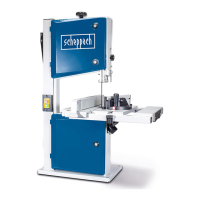28 GB
Side correction (Fig. 11)
• The sawblade should run in the centre of the band
wheels.
• Turn the upper band wheel by hand in the cutting
direction, and make the side correction by means
of the handle (J).
• Attention! The saw band should run over the cen-
tre of the band wheel after multiple turns. Visual
inspection!
• Turn the band wheel by hand in the cutting direc-
tion while determining the nal tension with the ten-
sion screw (11). The degree of tensioning depends
on the sawblade width. Wide sawblades must be
tensioned more than narrow ones.
• After successful setting rmly tighten the locknut
(N). Close the guard.
• Attention: Too strong a tensioning will cause pre-
mature breaking.
• Fit the table width enlargement in reverse order.
(Fig. 7-7.4)
• After termination of the work, always relieve the
tension by releasing tension bolt (11).
8.8 Setting the number of revolutions
(Fig.12+13+13.1)
Pull the mains plug!
• Open lower guard. The table top has to be tilted slightly.
• Release the belt with the tension handle (12).
• Put the belt into the desired position. (S1 or S2).
• Retension the belt with the tension handle (12).
• Close the lower guard.
Rpm range:
Rpm stage 660 m/min.
For processing hardwood, materials similar to hard-
wood and for ne cuts.
Rpm stage 960 m/min.
For processing softwoods and for less ne cuts.
8.9 Sawblade guiding (Fig. 14)
The sawblade guiding (4) is adjusted with the xing
button (13).
The upper sawblade guiding can be set from 0 to 175
mm work piece height.
A clearance as small as possible to the work piece
ensures an optimum sawblade guiding and safe
working.
Back pressure bearings (Fig. 15+16)
The back pressure bearings (e) accept the feed pres-
sure of the work piece. Set the upper and lower back
pressure bearing in such a way that it slightly touches
the sawblade back. Tighten the screws (g). The dis-
tance should be 0.5 mm.
Upper guide rollers (Fig. 15)
Set the upper guide rollers (f) to the corresponding
sawblade width. The front edges of the guide roll-
ers must not exceed the tooth base of the sawblade.
When the guide rollers slightly touch the sawblade,
tighten the screws (g).
Lower guide rollers (Fig. 16)
Set the lower guide rollers (i) to the corresponding
sawblade width. The front edges of the guide roll-
ers must not exceed the tooth base of the sawblade.
When the guide rollers slightly touch the sawblade,
tighten the screws (h).
The sawblade must not jam!
Storing the push rod (Fig. 17)
In order to have the push rod (R) to hand at all times,
hang it on the device (j) intended for this, at the top
left side of your band saw.
8.10 Transverse cutting gauge (14)(optional) (Fig.
18)
• Slide lateral stop (o) into a groove (k) in the saw
bench.
• Release the grip screw (l).
• Turn the lateral stop (o) until the desired angular
dimension has been set. The arrow on the lateral
stop indicates the set angle.
• Retighten the grip screw (l).
• The stop rail (n) can be slid against the lateral
stop (o). To do so, loosen the knurled screws (m)
and slide the stop rail (n) into the desired position.
Tighten the knurled screws (m) again
• Attention! Do not slide the stop rail (n) too far in the
direction of the saw blade.
8.11 On/Off switch (Fig. 1)
• To turn the machine on, press the green button „1“
On/Off switch (10).
• To turn the machine off again, press the red button
„0“ On/Off switch (10).
• The band saw is equipped with an undervoltage
switch. With a power failure, the band saw must
be switched back on again.
Attention!
When working with the machine, all protective devic-
es and guards must be tted.
The upper and lower bandwheel is protected by a
xed guard and an articulated cover. When open-
ing the cover, the machine is switched off. Starting is
possible only with closed cover.
9. Transport
The machine must only be lifted and transported on its
frame or the frame plate. Never lift the machine at the
safety devices, the adjusting levers, or the sawing table.
During the transport the saw blade protection must
be in the lowest position and near the table. Never
raise at the table!
Unplug the machine from the mains during transport.
10. Working instructions
The following recommendations are examples of the
safe use of band saws. The following safe working

